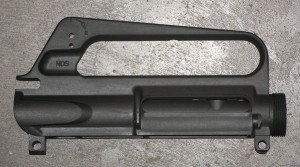
Colt M16 showing an XM16E1 forging with the forward-assist boss milled off. These upper receivers were made in early 1965. Image: from AR-15.com.
One of the more unusual “retro” M16 pieces is this upper receiver, which is an XM16E1/M16A1 forging processed into a a conventional M16 (no forward assist) part by milling off the forward receiver boss. There have been two stories going around about this unusual part: one, that it was a Colt prototype piece, and the other, that it was made for the Air Force. The second is the correct one, as we’ll explain below; and we’ll also provide primary documentation of how it came to be.
Thanks to that same documentation, we can set the upper bound of possible production at approximately 62,000 pieces. It stands to reason, then, that the appearance of this receiver on Colt prototypes like the celebrated Model 605 carbine is simply a case of Colt using, as was logical, leftover parts for toolroom prototypes.
For a while, NoDak Spud LLC made a replica of this upper receiver, but they have sold out and discontinued it. They called it the NDS-605 and sold it primarily to would-be builders of clones of that specific 6o5 prototype.
The Black Rifle, the best-regarded secondary source for M16 history, had the basic facts of the matter correct, along with a photograph of one of the Air Force M16s (Colt model 604) so equipped. But, as is typical for that book, no direct sourcing for its statements are included.
This discussion thread on AR-15.com, like many threads there, advanced a lot of ideas without a lot of supporting evidence. Informed supposition or speculation is not necessarily anathema, when it’s all you have. The thread does include photos of an original upper of this nature. But in the end, the last poster concludes that, sure, Colt did it, but “Don’t ask me why.”
Well, we at Weaponsman have a clue about that, and we have the primary source to explain it for you and take it out of the realm of informed supposition or speculation. Here’s the change history for Colt’s first M16/XM16E1 contract, Appendix 11, page 11-9 (for any of these, click to expand):
Once approval was won for the process, it was not long before Colt was actually asking for permission to execute it (same page, 11-9):
That request was approved 17 February 1965. And in April, 1965, they did it again (page 11-11; click for full size):
The narrative major-change history that is part of the same document igoes into a little more detail about why (Page 11-28):
In January, February, and March 1965, Colt’s subcontractor for the M16 upper receiver forgings was behind his delivery schedule. In order to meet the deliveries scheduled for the U.S. Air Force, Colt’s requested and received permission to utilize XM16E1 upper receiver forgings (with the bolt assist device) in fabricating MI6 upper receivers by milling off the forward assist boss.
An original Colt “605” upper, then, dates without question to Q1 Calendar 1965; the 62,278 number probably represents an upper bound on the number produced, and they were used in production in at least February, April and probably Match of that year. They were originally used in Colt Model 604 / USAF M16 Rifles. Some have suggested that Colt previously requested that the Air Force accept XM16E1 uppers with the forward assist, and the Air Force rejected them, but we haven’t seen documentary proof of that, like this document here proves the use of the receivers and the contemporary reasoning behind so doing.
Originally, the USG meant to order small quantities of AR-15s that would be used by special operations forces, and certainly wouldn’t supplant the Army’s in-house development, the M14, which was a slightly longer, heavier, M1 with a detachable box magazine. This plan was overcome by events. The powerful Air Force Chief of Staff, Curtis LeMay of bombing-of-Japan and Strategic Air Command fame, insisted on the M16. It also kept beating the M14 in tests, no matter how heavily Army Ordnance rigged the test in favor of their own gun. Soldiers who tried it mostly did not want to go back to the heavy, awkward, slow-firing M14.
The document is a treasure trove of M16 historical information, as is the whole 12-volume report of which it’s part. Its cut-off date for information appears to be around 1 October 1967 (the last approved changes to contracts were on 23 September 1967), but we’re still extracting data from it and may have missed an explicit statement of information cut-off date. Best of all, it provides a contemporaneous and authoritative explanation of when, what and most interestingly, why many running changes were made in the vital first three years of M16/XM16E1/M16A1 production.

Kevin was a former Special Forces weapons man (MOS 18B, before the 18 series, 11B with Skill Qualification Indicator of S). His focus was on weapons: their history, effects and employment. He started WeaponsMan.com in 2011 and operated it until he passed away in 2017. His work is being preserved here at the request of his family.





One thought on “The so-called “605” upper receiver”
The cut-off date for information was simple. They had to stop sometime just so they could write the report and release it.
A lot of the same data had been published in the Ichord Subcomittee hearing transcripts.